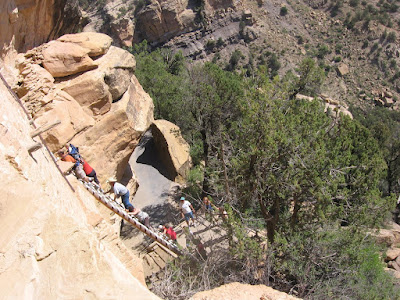The Balcony House Trail is one of the most popular sites for visitors to Mesa Verde National Park in southwest Colorado. The 32 foot ladder climb entrance and 12 foot hands and knees tunnel exit make this the most adventurous of the alcove cliff dweller sites. It is also a site where the scarcity of water for the residents comes into focus.
As visitors arrive at the double ladder to climb into the north side of Balcony House, they brace themselves, eyes turned upwards, for the climb. Perhaps little noticed is the damp spot just to the right of the ladder. Mesa Verde is inclined to the south at about a seven degree angle. This slight slope is important in the formation of the alcoves that shelter the spectacular ruins sites like Balcony House.
Alcove formation is helped along by water that is absorbed into the porous sandstone and flows downwards until it reaches an impervious shale layer that forces the flow sideways. The cementing calcium carbonate dissolves and allows the sand grains to be washed or blown away. Seep springs are sometimes found in the back or near the alcoves and provide a convenient water source for the residents.
Though it doesn’t look like much, with the vegetation cleared away and with the use of pottery dippers and mugs, the use of this small spring would be preferable to walking a long distance and hauling a heavy load. Water weighst 8.34 pounds per gallon and in this dry climate 40 residents would need at least 400 pounds of water per day, maybe twice that amount.
The Mummy Lake constructed reservoir on the Far View Trail is an example of what had to be done if there were no springs nearby. The Mug House Trail tour includes a discussion of a constructed cistern to catch runoff to provide water for that large site. During the summer of 2010 Mesa Verde is installing new water pipes along the main park road. The water supply for the park is pumped up from the Jackson Lake north of Mancos, CO, after arriving at Jackson Lake through constructed canals that catch and control the snowmelt from the LaPlata Mountains. Throughout the ages, we go to great lengths to manage our water resources.
(There are other posts that show the details of Balcony House. Use the Balcony House Trail label to find.)



No comments:
Post a Comment